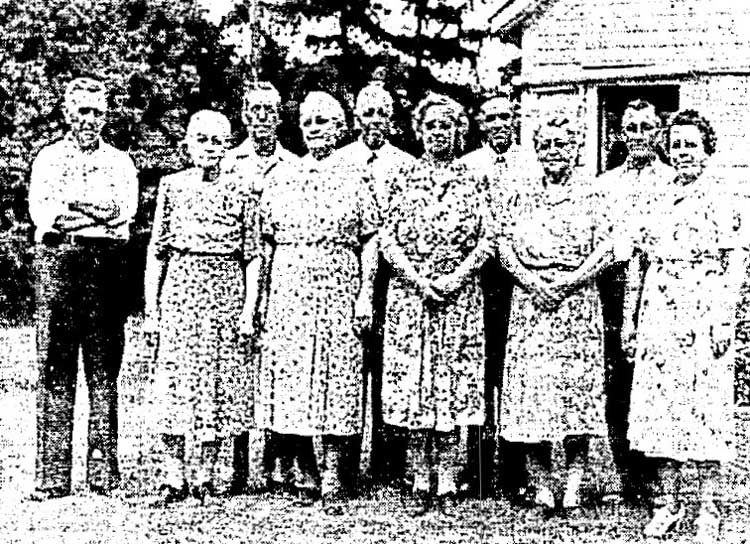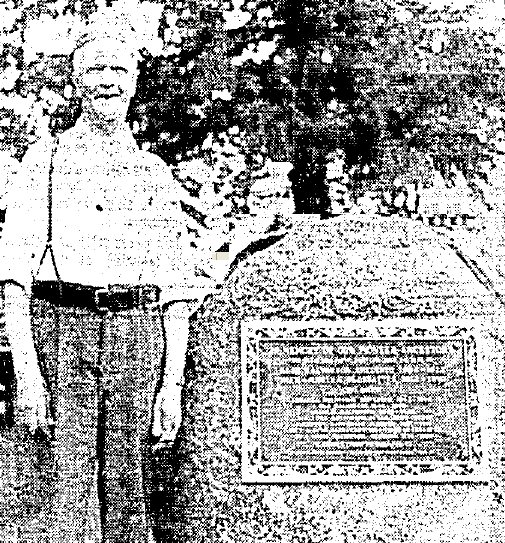|
for 95 Years
By Rena Jean Tesch
St. Ansgar, Iowa -- Midst the quiet and peaceful surroundings of a lovely old country home two miles south of St. Ansgar, encircled by a natural wooded area with fields of ripe grain and verdant corn in the distance, an unusual celebration was held last Sunday, when a bronze plaque commemorating the settling of the farm by the grandfather Hans Halvorson Smedsrud (Smedsrud name was eventually dropped) June 24, 1853, was dedicated in a special service in connection with the annual family gathering held. The farm, now under the management of Martin, Clara and Ervin Halvorson, has for the entire 95 year period remained in the Halvorson family. The boulder on which the plaque was placed, weighs one and one half tons, and was taken from another part of the farm. Carl Halvorson, Beach, North Dakota, grandson of the pioneer Halvorson, and Ingwald Halvorson, president of the clan, gave dedicatory addresses. Entwined with the Halvorson story is the story of an illustrious Scandinavian pastor, Rev. Claus L. Clausen, who was born in Denmark, moved to Norway as a child, then came to the U.S.A. when 23 years of age, settling first in Indiana, then in Wisconsin. He was the first pastor to preach a Norwegian sermon in Iowa. Ambitious for his Scandinavian people, who were poor in worldly goods, and scattered, the pastor fired the minds of many with travel to find more fertile lands and thus build a firm foundation for home and church. In 1850 the minister made a first tour, and finding no place suitable, went on a second journey, 1852, taking with him three staunch men, including the ancestor of the Halvorsons, Hans Halvorson Smedsrud. They journeyed in southern Minnesota, finally coming to Iowa, and there found a site south of Carpenter on Deer Creek, which they named because of the abundance of game. This was the answer to their prayers. Abundance of game, accessible water, plenty of good timber including maple, ash, elm, bass, walnut, oak, fertile land, good drainage, possible place for a town -- which later became St. Ansgar. So the four men built a sturdy log house, left it, returning to their native Rock county, Rock Prairie, Wisconsin, to tell the congregation and other stout hearted persons who wished to emigrate. The men contracted at Mineral Point, Wis., for covered wagons. Intensive were the preparations for a journey to a new land. The men on the first two pilgrimages had walked. This journey was to be made by covered wagons, oxen-drawn with a lone pony and a span of horses drawing the carriage of the Rev. C.L. Clausen and his family. The party could not begin its journey until the grass was long enough to feed 200 or more cattle herded beside the wagons. The wagons crossed the Mississippi at the mouth of the Wisconsin on a ferry driven by a treadmill operated by a blind horse and a mule. A storm arose when one group crossed and there was great trepidation. Indians had to be watched carefully, as there was still danger in some areas, and wolves were a menace at night. Game and fish supplied the food along the way.
Dissension arose in the group but the claim was already jumped so Smedsrud with his family moved on, staking a claim where the original home now is. Members in the other 40 wagons settled along the river in and around St. Ansgar, and dark days were ahead for even the stoutest hearted pioneer. The first crop was of potatoes, rutabagas and corn. Plowing was difficult, grubbing had to be done. Houses had to be made, Children and women became ill. In 1854 the first Indian scare came, and in 1862 another scare. In 1856 the great December blizzard came with snow piled high until the following April. The thermometer was reported to have reached 55 below. Many went back from the Clausen colony, but not the Halvorsons. The infant Inge Aleeta died in 1854 and two years later, Inge Maria was born. Four children beside Inge Aletta had come with Hans Halvorson Smedsrud and his wife, Martha Oldsdatter, namely Helena Halvorson Bergerson, Ale, Andrew and Bergethe. Andrew, father of the three descendants on the home place, now, died in 1939. The youngest, Inge Maria Jacobson, Clear Lake, Died in 1939. Andrew, who remained on the home place, married Lucinda Helgesen and the couple had 12 children, all of whom are living, all of whom were born on the home place. They include Mrs. George Johnson, (Helen), Henry and Albert, Hawley, Minnesota; George, St. Ansgar; Mrs. Iver Dahl (Maria), St. Ansgar; Martin, on the home place; Mrs. Carl Dahl (Ida), St. Ansgar; Clarence, St. Ansgar; Clara, on the home farm; Elmer, St. Ansgar; Irvin, home farm; and Lorene Davenport, Boonton, N.J. In the family of Ole, the only other child of the original family who remained in this territory, the four children are all living, namely, Herman, Cedar Falls; Mrs. C.P. Heltne, Decorah; Carl, Beach, N.D., and Ingwald, Osage. First and present president, succeeding himself every year is Ingwald Halvorson, Osage. First secretary was Lorene Davenport, who has been absent for 13 years, and came home this year, to be present for the occasion. Present vice-president is Mrs. David Opdahl, Emmons, Minnesota, and present secretary is Mrs. Ben Skadeland, Clear Lake. The secretary reported that this was the 30th annual meeting, that the family tree had grown by 11 births and nine marriages last year, and that there was only one death. There are 449 names in the family roster, with 363 living and 86 deceased. Seventy-five were present Sunday, with Clear Lake, Osage, Des Moines, West Des Moines, Decorah, Mason City, St. Ansgar, Cedar Falls, Iowa, Lyle, Emmons, Albert Lea, Clarks Grove, Dodge Center, Glenville and Alden, Minnesota; Boonton, New Jersey and Beach, North Dakota, represented. |
Webization by Kermit Kittleson, 7/2009

